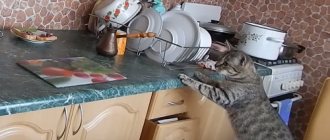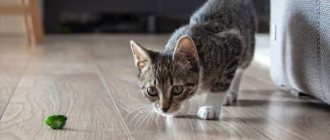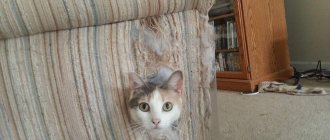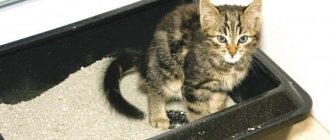Most cats are accustomed to the fact that they can roam around their territory in any part of the apartment. The place for their walks is often a table. Of course, many pet owners do not see anything wrong with their animals’ behavior, but others believe that having a pet on the table is bad manners and a real hotbed of infections.
Why does the cat walk on tables?
The cat does not always steal food from the tables. Of course, this is a fairly common reason for a pet to appear on such a surface, but it is far from the only one.
Among the main factors that encourage a cat to visit this place are the following:
- showing curiosity. It is quite possible that before leaving home you put some interesting thing on the table for your pet. Cats are creatures who are interested in everything. If they have already explored the entire apartment, every corner of it, be prepared for the fact that they will also begin to climb onto the table, especially if you leave something there;
- theft of products. Most often, cats climb onto the kitchen table for leftover food. You shouldn't put all sorts of goodies here after your meal is over. A domestic predator will quickly understand what's what. In addition, for this animal a piece of stolen food is a kind of prey;
- daytime nap. Interestingly, the cat loves to nap in a place where there is a smell of food. These scents calm her down. That is why a pet can choose a kitchen countertop as a place to sleep;
- adoration of high surfaces. The cat likes to climb higher to observe the situation in the house. Such a pet can often be seen on the windowsill, because it offers a wonderful view of the street. It’s hard to find a more interesting activity for a furry pet than watching what’s happening from above. This is why the cat may often climb on the table. By the way, in most cases, he develops such a habit when you have several pets living in your house at once;
- looking for a warm place. If your home is cool in winter, be prepared for the cat to find a way out. The higher it is located above the floor level, the warmer it is.
When the reason for this behavior in your cat is clear to you, it’s time to start fighting the bad habit.
What not to do
When you see a cat climbing on tables, you should not rush to scream and run away with punishment. First of all, you need to understand that cats do not perceive human methods of influence the same way as people do. A person is able to distinguish between the correctness of his action and more than a thousand different intonations in the voice of his interlocutor.
Cats cannot do this, so their reaction to swearing and assault will be different. They will not understand why they are being shouted at, and, moreover, why they are being beaten - cats do not always recognize being on certain furniture as something bad. They do not know that they have committed a crime, and they may become offended, angry and do something out of spite. A cat that is softer in character may begin to be afraid of people.
Methods that are not suitable for the cat’s breed or character are unacceptable. There are individuals that are more sensitive to noise, and it is very easy to scare them excessively. The same goes for kittens of any breed.
Each of the weaning methods needs to be considered more closely. For example, some cats love water very much, and it will only draw even more attention to the table. On the other hand, water can frighten a cat, and stress in the animal will not be long in coming.
Negative examples include a rug that shocks. It will, of course, scare the pet away from the table, but the consequences can be unpleasant, and there can be no question of humanity. There is a good alternative - a vibration mat that will gently and without unnecessary stress discourage your cat from the table and other unwanted places. There are varieties with sound signals that are better for the cat.
The moment when a cat climbs on tables can be compared to a bad habit in humans. It’s difficult to get rid of it, but you can “replace” one habit with another: it’s ideal if you can replace a bad habit with a useful one. For example, sitting on a chair next to the owner.
Ways to teach your pet a lesson
If a cat climbs on the kitchen table, you need to stop such liberties. There is no point in throwing a kitten off the surface or hitting it. You won’t achieve full results, but you can ruin your relationship with your cat. Let's look at the main ways to raise your pet.
Scaring sounds
In order to wean your cat from climbing on work surfaces in the kitchen, leave tin trays or bowls in the center of the countertop. The next time the animal jumps there, the dishes will fly down with a crash. Such a sound will certainly frighten your pet, and if not the first time, then after several such situations he will forget about this surface.
Since your furry pet doesn’t like loud, unpleasant sounds too much, you can take advantage of this in the process of instilling good manners in him. Cover the tabletop with foil or plastic bags. When the cat starts rustling on the table with its paws, it will simply be afraid of the effect.
Strong odors
If the cat continues to climb onto the table, it’s time to use pungent scents, because they can also scare the animal. A good way out of the situation would be to treat the countertop with a vinegar solution. Of course, the smell will persist for some time, but the cat will stop dozing on this surface.
Alternatively, place a few wedges of fresh lemon on the table or sprinkle some lemon juice on your napkins. The cat also does not like the aroma of citrus fruits, and this is worth remembering if you want to wean her from climbing on the table.
Irritating surface
When a kitten jumps on the table, it is important to promptly fix in his mind the not-so-pleasant associations with such a process. To do this, place a baking tray with cold water in the center of the surface and wait until your cat decides to try his luck again. After a swim, the pet will be seriously scared, so it is unlikely to try to climb onto the table again.
Watch the cat during the process. If she suddenly decides to be cautious and bypass the baking sheet, place her paws in the water. In this case, a reflex will be fixed in her consciousness: the table is an unpleasant place for her. True, it is quite possible that you will have to repeat this procedure.
Double-sided tape should also be considered an irritating surface. You can use it to cover your kitchen work surface. A cat, having once walked across such a table, will no longer want to repeat its experience. However, keep in mind that peeling off the tape is not so easy.
Radical methods
You can wean your cat from walking on the table using more radical methods. Buy a special electric mat, spread it on the countertop and connect it to the network. The cat will receive a light shock as soon as he jumps in there again. Such measures will once and for all help your pet forget about his favorite prank. There is no need to worry about the cat’s health - a little current will not harm it in any way, but you will certainly achieve the desired effect.
What mistakes should not be made
Unfortunately, often the owners themselves provoke their pets in many ways, encouraging them to climb on tables. In order for the educational process to be quick and productive, it is recommended that owners themselves adhere to a number of rules:
- Every time after eating, thoroughly clean the table, removing from it all foreign objects that may interest the cat and arouse its curiosity. To enhance the effect, the surface can be treated with table vinegar or lemon juice.
- Make sure the animal is well-fed. Before leaving the house for a long time, be sure to feed the cat, leave a sufficient amount of food and clean water in its bowls.
- Be careful and remove dirty dishes, crumbs, and leftover food from the table every time so that the animal has nothing to steal. The same goes for the sink and kitchen cabinets. You should wash the dishes in a timely manner, and put leftover food in the refrigerator after a meal.
- Provide your pet with a personal space and a comfortable sleeping place. It is advisable that it be located near a battery or other heat source.
- If the table is located near a window, cover it with curtains. And in order for the pet to be able to freely observe birds and other interesting things happening on the street, move a chair or other piece of furniture to the window.
It is also important to provide the animal with a sufficient number of toys, scratching posts (read also how to accustom a kitten to a scratching post), and, of course, devote time to playing with it. Very often, cats climb on tables simply out of boredom or out of a desire to at least in this way attract the attention of their beloved owner.
How to prevent your pet from developing the unpleasant habit of climbing on the table from a young age
The kitten may simply not understand where his territory is and where yours is, therefore, it is worth persistently demonstrating to him where he should not be, each time picking up the baby in his arms and carrying him to the permitted place. The kitten may perceive you as a mother cat or think that if people eat at the table, then he can too. Be patient and persistent. He must understand “who is the boss of the house.” You can lure the baby to the places designated for his stay, treating him with goodies purchased at the Veterinary Pharmacy or at the Homeovet pet store. He must learn to understand where his dishes are and where his safe resting place is. Feed him at a time, in the corner designated for eating, preferably this time coincides with your own meal. This way he will develop useful instincts that he will follow. Do not pick up the baby if you are sitting near the table, otherwise the explorer instinct may take over. Among other things, the intonation of voice with which you address the kitten will soon become clear to him and he will understand what mistakes in his behavior “mother” is dissatisfied with.
What is not recommended to do to stop a cat from climbing on the table?
To determine the objective and most adequate method of education, you must first determine what causes your pet too much discomfort or extreme fear. Such methods should be avoided. For example, if a cat is shy and impressionable, then you should not scream too emotionally, scold your pet or make noise so as not to scare it. So the animal may have unpleasant associations not in relation to the table on which it is forbidden to walk, but in relation to you.
If you hurt an animal during the educational process, this may push him to retaliate. The animal may become aggressive, resorting to self-defense and even attacking you.
Creating stressful situations for the animal should be avoided. This can lead to distorted behavior and perception, ruining the cat's character and relationship with it.
It is necessary to ensure as loyally as possible that the table is not considered by the animal as a place for games, sleep or pleasure. So interest in him will be lost. It is always worth finding an alternative for your pet, using the advice of consultants at the Veterinary Pharmacy or the Gomeovet pet store.
Punishment system
Experienced breeders know that pets react sensitively to scolding and punishment. But it is important to be careful not to harm the kitten or spoil the relationship with the pet.
Each of these methods requires enormous patience, since the animal does not understand the severity of the prohibition the first time , and some of them perceive a curse for playing, so it is necessary to remain cool and not succumb to the action of a cute little face, but at the same time remain calm so as not to harm the baby, but also avoid severe psycho-emotional shock.
How to stop a cat from walking on the kitchen table - Everything will be fine. Issue 1078 from 08/29/17
Unpleasant smell and foil
Kittens cannot tolerate the aroma of fruits and flowers , so one of the methods of dealing with active pets is essential oil based on orange or lavender, which is used to lubricate the surface. The disadvantages of this method include the high likelihood of an allergic reaction.
Cats prefer to play pranks silently, and foil placed on the table immediately signals an uninvited guest on the table. This scares the animal away from the forbidden place. Next time he will refuse such a prank. However, this method does not work for long: as soon as you remove the foil and put something tasty on the table, the fluffy will try to “steal” the treat.
Video: raising a cat correctly
Practice shows that the method using citrus essential oils is practically fail-safe. It effectively solves the problem of a cat climbing on tables in your absence and fills your home with a pleasant and refreshing aroma, which, by the way, also has a positive effect on your health, having immunostimulating and antiseptic properties. The main thing is that until the cat learns to walk where it is not supposed to, do not forget to treat the necessary surfaces before leaving the room. As with any treatment, the main thing here is systematicity.
Why the kitchen?
First of all, there is so much to do in the kitchen! Agree, where else can you see a real meat grinder, get acquainted with a seaming machine, meet plates with pieces of lunch carelessly left in the sink, see so many jars on the countertop that you can play with while the owners are busy with their own affairs?
In addition, it is in the kitchen that a large number of different aromas accumulate - fish, meat, hot, sweet, spicy. And cats, as you know, have an excellent sense of smell, which, coupled with curiosity, makes them explore the kitchen far and wide.
It is also important that the cat most often eats itself in the kitchen, which means that it is always tempted to taste the host’s dishes, which lie appetizingly on plates or in salad bowls. Sometimes the owners themselves help her in this, who like to feed the purr from the table, thereby making it clear that she is openly welcome in the kitchen, and she is at her complete disposal day and night.
Reasons for deviant behavior
We love our pets with all our hearts, but we must admit that the squad of furry domestic terrorists should be divided into subcategories:
- Caressing cat;
- Thief cat;
- Taskmaster Cat;
- Tracker cat;
- Frozen cat;
- The cat is an ordinary cat.
We need this to establish the reason that prompts the cat to climb onto the table, and to choose a method for correcting the situation.











